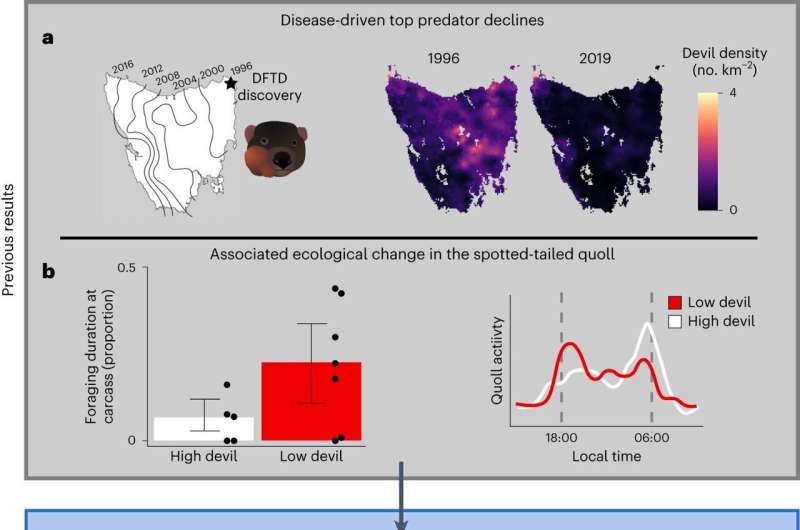January 9, 2024 report
This article has been reviewed according to Science X's editorial process and policies. Editors have highlighted the following attributes while ensuring the content's credibility:
fact-checked
peer-reviewed publication
trusted source
proofread
Decline of Tasmanian devil could be causing genetic changes in spotted-tailed quoll, study finds

An international team of evolutionary biologists and natural scientists has found that the population decline of the Tasmanian devil is likely leading to genetic changes in another local predator—the spotted-tailed quoll. In their study, reported in Nature Ecology & Evolution, the group collected quoll tissue samples and conducted a genetic analysis and comparison of quolls over 15 generations to learn more about their evolutionary history during the time the devils have been in decline. A Research Briefing outlining the work has been published in the same journal issue.
Prior research has shown that Tasmanian devil numbers in Tasmania have been dropping drastically over the past 30 years. Prior research has also shown that the reason for the decline is devil facial tumor disease (DFTD), a lethal type of infectious cancer. Their numbers have dropped from approximately 53,000 in 1996 to just 16,900 in 2020. Prior research has also suggested that top-predator declines tend to have a dramatic impact on their local community. In many instances, another predator steps in to fill the missing niche.
In Tasmania, that predator is the spotted-tailed quoll—a marsupial with a diet similar to that of the devil. Both species hunt at night, but quolls are smaller than devils, which means that until the advent of DFTD, devils were the top predator. In this new effort, the research team explored the impact DFTD has had on the quolls.
The researchers went out into the field and trapped 345 specimens to collect tissue samples (from the lower part of one ear) over the years 2004 to 2019. They then conducted a genetic analysis of the samples, which resulted in the study of 3,431 variants over 15 generations of quolls.
In comparing the genes over generations, the research team found that quolls living in areas of high DFTD (and thus lower populations of devils) were more genetically similar to one another than those living in areas where DFTD was more limited.
They also found differences in 12 variants that could be linked to reductions in devil populations. Among them were genes associated with movement and muscle development. The researchers suggest this makes sense because quolls living in areas with fewer devils did not have to move around as much when competing for food.
More information: Marc A. Beer et al, Disease-driven top predator decline affects mesopredator population genomic structure, Nature Ecology & Evolution (2024). DOI: 10.1038/s41559-023-02265-9
Disease-driven decline in a top predator affects evolution of a competing mesopredator, Nature Ecology & Evolution (2024). DOI: 10.1038/s41559-023-02274-8
Journal information: Nature Ecology & Evolution
© 2024 Science X Network




















